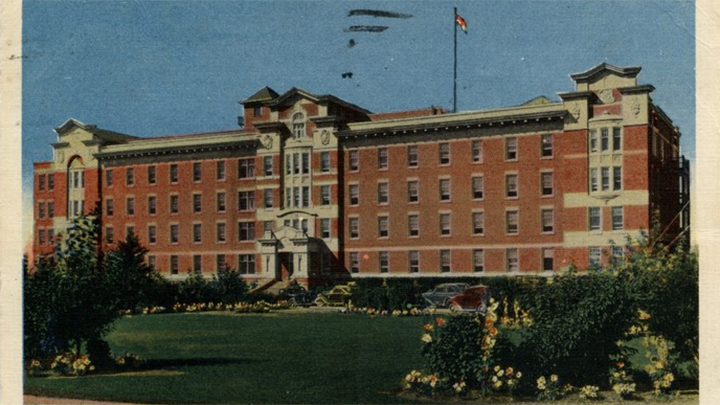
December 18, 2018

The blueprints of the old University Hospital were part of a cornerstone time capsule that was laid in the building in 1913. Thought to be lost for years, the originals mysteriously reappeared in 2016. Today, reproductions are on permanent display on the University of Alberta’s second floor hallway near its escalators. Here is how the hospital appeared on a 1950s postcard.
Story by Sharman Hnatiuk
EDMONTON — Rhonda BerryHauf can’t wait to see if the old University Hospital blueprints match the image she has in her dreams.
The clinical nurse educator with the Alberta Kidney Care North program, who has an office in the University of Alberta Hospital (UAH), has a strong connection with the original building which opened to patients in 1914 and was torn down in 1983.
“I must have been five or six years old when we came to the University Hospital from my hometown of Bashaw in order for me to undergo a medical procedure,” says the 55-year-old. “I can remember they had a large aquarium, and I stood there watching the fish while my parents were checking me in.”
When BerryHauf returned to the University Hospital in 1980 to begin training as a student nurse, she was pleased to find the aquarium still present on the main floor.
BerryHauf has fond memories of living in the nursing dorm across the street as she learned to care for patients throughout the six-floor hospital. From the dome in its operating theatre, with curtains that could be drawn back so medical students could peer from above, to her rotation in the labour and delivery unit, to the thick frosty goodness of the milkshakes at the second-floor short-order diner — Berry can’t help but smile when she thinks back on the hospital.
For many of the physicians who worked there, the doctor’s lounge was the heart of the building, a place to meet and to discuss their work and their patients.
Dr. Lorne Tyrrell, an infection disease physician who positioned the UAH as a leader in hepatitis research and treatment, spent time as an intern and resident in the original building in the late 1960s and early 1970s.
“You would walk in and right away on your left was a doctors’ lounge. You had to pass through there to hang up your coat and pick up your mail and, of course, to get your coffee,” he says.
While many buildings have come and gone over the history of the University of Alberta Hospital campus, two constants have endured — its compassionate care of patients and its sense of community.
“We have many patients, families, staff and physicians with an incredible story to tell who feel connected to the old University Hospital,” says Cathy Osborne, Senior Operating Officer, UAH, Mazankowski Alberta Heart Institute and Kaye Edmonton Clinic. “The building may be gone, but people remain connected to the history and evolution of care provided across the footprint of the UAH campus.”
The blueprints of the old facility were among keepsakes placed into the cornerstone time capsule that was laid in the building in 1913. The cornerstone and its contents were moved when the building was demolished to make room for the Clinical Sciences Building, and had been thought lost — until the blueprints mysteriously turned up in 2016 on the desk of the late Dr. Richard Fedorak, gastroenterologist at the UAH and dean of the University of Alberta’s Faculty of Medicine & Dentistry.
Dr. Fedorak arranged to have the blueprints and newspapers restored by the Provincial Archives of Alberta and then housed at the University of Alberta’s Research Collections Facility.
Reproductions of the blueprints are now on permanent display on the UAH’s second floor, near the escalators.